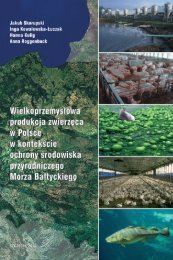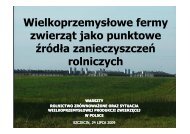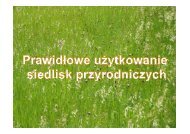best available technologies for manure treatment - Baltic Green Belt
best available technologies for manure treatment - Baltic Green Belt
best available technologies for manure treatment - Baltic Green Belt
Create successful ePaper yourself
Turn your PDF publications into a flip-book with our unique Google optimized e-Paper software.
Best Available Technologies <strong>for</strong> <strong>manure</strong> <strong>treatment</strong> baltic sea 2020<br />
FOREWORD<br />
FOREWORD<br />
One main objective <strong>for</strong> <strong>Baltic</strong> Sea 2020 is to reduce the eutrophication<br />
of the <strong>Baltic</strong> Sea. The reduction of nutrient leakage from intensive<br />
livestock farms to the <strong>Baltic</strong> Sea, through technical development<br />
and spreading in<strong>for</strong>mation on “Best Available Technologies” is one<br />
important activity to reach this objective.<br />
This report with findings and recommendations concerning “Best<br />
Available Technologies <strong>for</strong> Manure Treatment” is produced by Henning<br />
Lyngsø Foged and his colleagues at the Innovation Centre <strong>for</strong><br />
Bioenergy and Environmental Technology (CBMI), commissioned by<br />
<strong>Baltic</strong> Sea 2020.<br />
The report focuses on leaching of nutrients from the huge<br />
amounts of <strong>manure</strong> produced by intensive rearing of pigs in the<br />
EU Member States of the <strong>Baltic</strong> Sea catchment area, and evaluates<br />
the technological solutions to reduce this leaching. The report does<br />
not evaluate the leaching reduction potential of agricultural practices,<br />
such as spreading techniques, timing of spreading, buffer areas,<br />
wetlands etc. These important measures are discussed by many other<br />
actors involved in reducing eutrophication in the <strong>Baltic</strong> Sea.<br />
<strong>Baltic</strong> Sea 2020 will promote the recommended <strong>technologies</strong><br />
within the <strong>Baltic</strong> Sea catchment area. We hope that other organisations,<br />
institutes and authorities will find the report useful and apply<br />
its findings, <strong>for</strong> example in the review process of the IPPC Directive<br />
and its reference documents, in agricultural advisory services, within<br />
the <strong>Baltic</strong> Sea Strategy and within the multiple ongoing projects<br />
aiming to develop intensive animal production within the <strong>Baltic</strong> Sea<br />
region in an environmentally sustainable way.<br />
Stockholm January 2010<br />
Conrad Stralka<br />
Executive Director <strong>Baltic</strong> Sea 2020<br />
Lotta Samuelson<br />
Project Manager <strong>Baltic</strong> Sea 2020<br />
3









